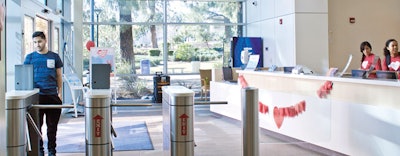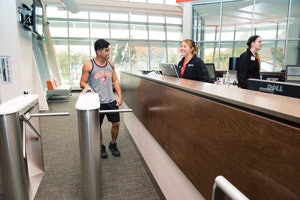
Modernizing existing athletic facilities has become a priority for many colleges and universities as they compete for the all-important student dollar. Campus recreation centers in particular have evolved into recruiting anchors for those schools, but despite consistent investments in facility amenities, many rec centers have been slow to replace their older access-control methods with more modern options like biometrics, which matches finger, hand or iris scanning with a member's profile.
According to a recent AB survey of campus recreation managers, approximately 20 percent of respondents indicated they are currently utilizing biometrics at their facilities, while nearly half of all respondents still prefer to use magnetic card readers as their primary access-control method. While biometrics implementation on the college rec level dates back close to two decades, many programs either still cannot grasp how the process works or they find themselves locked out financially.

ALL ABOUT THE BENJAMINS
Finding the funds necessary can be a major challenge for rec managers. According to the AB survey, nearly one-half of respondents cite money as the primary reason they haven't implemented biometrics at their facility. One approach is to build that expense into a new construction or renovation budget, which is what Bowling Green State University did with its $14.2 million student recreation center renovation last year.
Steve Kampf, assistant vice president of student affairs, director of recreation and wellness, visited more than 50 campus recreation centers with colleagues for approximately five years to generate ideas for BGSU's soon-to-be-state-of-the-art facility. While in Florida, he came across biometrics. "Once we saw it, we thought this could be the answer to some of our problems," Kampf says, referring to students either forgetting their ID card or passing their ID card to other people.
San Diego State was an early adopter of the biometrics hand-scanning process, something Rick Craig witnessed firsthand. Now director of recreational services at California State University San Bernadino, Craig implemented the same approach to access control when CSU San Bernadino opened its new rec facility in 2007.
"The response was mostly positive by students and staff, but there were a few people who were afraid of big brother or were germaphobes," Craig says. "Now we've had it eight years and hardly anyone complains."
For those college rec administrators who cannot build this expense into an upcoming construction budget, there is also a potential cost savings option to justify the investment. Says Craig, "With that person no longer needing to scan IDs, they can do other things. I know I'd have to have another staff member if I didn't have biometrics."
"I think the issue with slower adoption is perceived cost," says Tom Diehl, former director of recreational sports at Virginia Commonwealth University. Diehl, now working in residential life, oversaw the installation of biometrics at VCU's rec facility. "People don't realize all the benefits that come from biometrics, including tracking and data," he says. "And instead of six or seven students sitting behind a desk, we have six or seven turnstiles."
MODERN FAMILY
The University of Richmond built its recreation facility eight years ago, and Tom Roberts, assistant vice president, rec and wellness, began researching biometrics a few years prior to that. "At the time, it wasn't common, but people were experimenting with it," Roberts says. Richmond opted for hand biometrics, which was met with skepticism — not by the students themselves, but some of the university's staff and outside community that used the facility.
"They were concerned it was taking fingerprints, which it's not," adds Roberts. "It's taking 90 separate measurements. Once they got over that hump, people were fine with it." As part of the process, members have to input an eight-digit identification number prior to the scan, but Roberts says the process takes very little time and eliminates members fumbling in their wallets, purses or pockets for their card. "I think it's smoother this way and more accurate," he says.
While Roberts admits that security did not play a major role in selecting biometrics, as the campus is fairly secluded, the same cannot be said for its neighbors down the street at Virginia Commonwealth University. An urban school, VCU has private businesses surrounding it with the general public a constant concern. Says Diehl, "We have people every day that try to get into the building to play basketball, get warm or use the bathroom. Biometrics has made a huge difference in terms of security."
Prior to biometrics, VCU students would prop doors open to let someone in or, back in the days of swiping a card, students would swipe their card and then slide it through the crack of the door for another person to use, minimizing the amount of control staff had over who was in the facility and what those people brought in with them.
By contrast, BGSU opted for the finger-vein scanner. Once staff has entered a student into the system, that student's finger is scanned. Subsequent scan matches release the turnstile and allow access to the facility. The process can take a bit longer than hand-scanning — Kampf estimates anywhere from 10 to 20 seconds — but even that amount of time has helped improve the flow of traffic (2,500 visitors daily) into the facility.
"Students are very excited about using new technology in a new building," Kampf says. "There's all new equipment and a new way to get into the facility. They are super excited about it."
 (Photo courtesy of Bowling Green State University)
(Photo courtesy of Bowling Green State University)
OBSTACLES REMAIN
Despite so many positives, there are still challenges. For Kampf, the most daunting part of the process was getting every member's finger read the first time. During the first two weeks of school, BGSU set up additional kiosks around campus to get everyone in the system, but even then, there were complications. "It doesn't work for everybody," says Kampf. "For whatever reason, it doesn't read the vein of some people. It's a small few, between five and 10 percent of our population. We find there are more problems when the temperatures drop or it's humid out." To alleviate this problem, as well as any other concerns its members had about biometrics, BGSU still gives members the option to use their ID. To date, Kampf estimates approximately one in every five is using his or her ID instead of biometrics.
Other colleges and universities do not offer the card versus biometrics option for one simple reason: they do not have student identification cards. California State University Northridge, for example, is not a card-issuing school, so when it opened its new rec facility in 2012, the decision to go with biometrics was an easy one.
"For the convenience of the user, the decision was made to implement biometrics so students wouldn't have to bring anything with them," says membership and aquatics manager Kaila Lavin. "You can't forget to bring your hand."
Lavin encountered similar challenges as Kampf, including the preregistration process. Northridge was able to register 3,000 hand templates prior to the facility opening, but all of that effort was for naught as technology issues rendered those scans unusable. "We pretty much did all that work for nothing, and that was pretty challenging," admits Lavin. Even with registration complete, the process still presents trying moments for Lavin. "It's a challenge every day in terms of education. We have an older population of students who have a harder time adapting to biometrics, and there are people who either don't like using it or physically can't for whatever reason."
Other valid concerns associated with biometrics include software and maintenance issues.
"The actual equipment is not cheap, and the maintenance is pretty labor-intensive," Lavin says. "We're lucky that we have two full-time IT people who work for us, which allows us to do preventative maintenance and upkeep ourselves."
While the adoption of biometrics has been a slow process, it has been a steady one, and its present and future impact in undeniable. An increasing number of recreation centers and athletic facilities are using biometrics for access control, to rent out equipment (as is being done at Cal State Northridge), or to verify identity for team locker room and individual locker access.
"Biometrics has been improving over time," says Diehl. "Originally, people thought we were taking a fingerprint and we would have to explain it's actually a finger recognition system. Now, these systems are simply looking at the vein in your hand or finger. It's really accurate and I don't see a lot of downside."
This article originally appeared in the April 2015 issue of Athletic Business with the title "Scan Do"
































